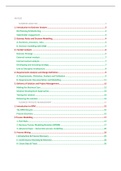INHOUD
BUSINESS ANALYSIS ................................................................................................................. 3
1. Introduction to Business Analyse ................................................................................................. 3
BA Planning & Monitoring ........................................................................................................... 3
Stakeholder engagement ............................................................................................................. 3
2. Business Rules and Decision Modelling ........................................................................................ 4
A. Decisions, processes, rules....................................................................................................... 4
B. Decision modelling with DMN ................................................................................................. 5
3. Context analysis .......................................................................................................................... 6
Business Strategy ........................................................................................................................ 6
External context analysis ............................................................................................................. 7
Internal context analysis .............................................................................................................. 7
Developing and executing strategy .............................................................................................. 7
Link to Enterprise Architecture .................................................................................................... 8
4. Requirements Analysis and Design Definition .............................................................................. 9
A. Requirements, Elicitation, Analysis and Validation .................................................................. 9
B. Requirements Documentation and Modelling........................................................................ 11
5. Delivery of Solution and Project Management ........................................................................... 12
Making the Business Case .......................................................................................................... 12
Solution Development Approaches............................................................................................ 13
Testing the solution ................................................................................................................... 14
Delivering the solution .............................................................................................................. 14
BUSINESS PROCESS MANAGEMENT ....................................................................................... 15
1. Introduction to BPM .................................................................................................................. 15
The BPM lifecycle ...................................................................................................................... 15
Process discovery ...................................................................................................................... 15
2 Process Modelling ...................................................................................................................... 17
1. Petri Nets............................................................................................................................... 17
2. Business Process Modeling Notation (BPMN)......................................................................... 17
3. Advanced topic – declarative process modelling .................................................................... 20
3. Process Mining .......................................................................................................................... 22
I.Introduction & Process Discovery ............................................................................................ 22
II. Conformance Checking & Extension ....................................................................................... 24
III. Event Data & Tools ............................................................................................................... 26
,4. Process verification, validation and certification ........................................................................ 27
I. Syntactic Quality: Verification ................................................................................................. 27
II. Semantic Quality: Validation ................................................................................................. 27
III. Pragmatic Quality: Certification ............................................................................................ 27
5. Qualitative process analysis ....................................................................................................... 28
Value-added Analysis ................................................................................................................ 28
Waste Analysis .......................................................................................................................... 28
Issue Documentation ................................................................................................................. 29
Root Cause Analysis ................................................................................................................... 29
6. Quantitative process analysis .................................................................................................... 29
Flow Analysis ............................................................................................................................. 29
Queuing analysis ....................................................................................................................... 30
Simulation ................................................................................................................................. 30
7. Process redesign ........................................................................................................................ 31
Business Process Reengineering (BPR) ....................................................................................... 31
Heuristic process redesign ......................................................................................................... 31
8. Process automation ................................................................................................................... 33
,BUSINESS ANALYSIS
1. Introduction to Business Analyse
BABOK (Business Analysis Body of Knowledge)
Knowledge areas: BA Planning & Monitoring (cf. infra), Enterprise Analysis, Requirements Analysis
Elicitation (wat hebben stakeholders nodig; focus groups, interviewing)
What is a Business Analyst?
Problem solver, facilitator, negotiator, architect, planner, communicator, expert, strategist
Competences of a Business Analyst
− Business knowledge (business acumen, industry knowledge, IT)
− Analytical thinking
− Organizing and Time management
− Communication and Interaction
− Tools and techniques
BA Planning & Monitoring
Planning parameters
− Objective
− Needs
− Scope (controle over houdenscope drift; naar mate project vordert andere doelstelling/…)
− Approach
− Activities (what is required?)
− Complexity & Risk
− Approval
Stakeholder engagement
Hoe communiceren naar stakeholders, en hoe betrek je ze in het proces?
Identify Attitude Expectations Contribution Communication
Stakeholder matrix: power of stakeholder/influence vs. impact on the improvement initiative
− Keep satisfied (high influence, low impact)
− Key players (high, high)
− Monitor (low, low)
− Keep informed (low, high)
Onion diagram
RACI matrix: Responsible, Accountable, Consulted, Informed
Communication Plan
, 2. Business Rules and Decision Modelling
A. Decisions, processes, rules
Focus op operational decisions
(niet tactical/strategic decisions)
Decisions in processes
- inside a knowledge-intensive activity
‘classify task’
- as shown by a simple gateway (XOR)
- as shown by a cascade of gateways
⇒ Rule Task
Decision Modeling & Notation standard (DMN)
- door business people, niet door IT’ers!
- decision automation; decision service
DMN models can be automated using a Business Rules Management Systems (BRMS)
DMN: two modelling levels
− The Decision Requirements level (inputs required)
− The Decision Logic level (how Is outcome determined?)
Business rules
Other business rules (naast decision rules)
- behavioural rules & constraints
- timing rules
- task allocation rules
Examples slide 35
Policies and rules:
- operative business rule: specifies conduct or behaviour, can be violated
- structural business rules: can not be violated (wel misunderstood/misapplied)
Modelling business rules
- natural language
- logic
- Structured English Rules (subset of English, in between logic and natural language)
- Decision trees, tables, graphs, diagrams
- Object Constraint Language
Rules taxonomy (how to categorize business rules) /!\ RULES KUNNEN INDELEN
- Derivations
Computations
Inferences (if then else)
- Constraints (never balance <0, no if-then-else)
State constraint
Transition constraint
Stimulus constraint




